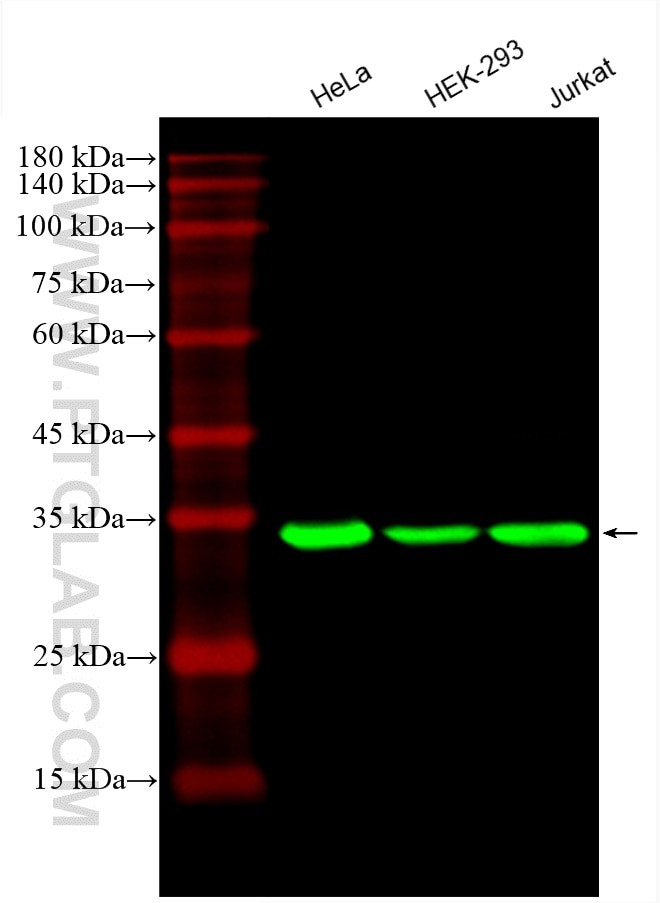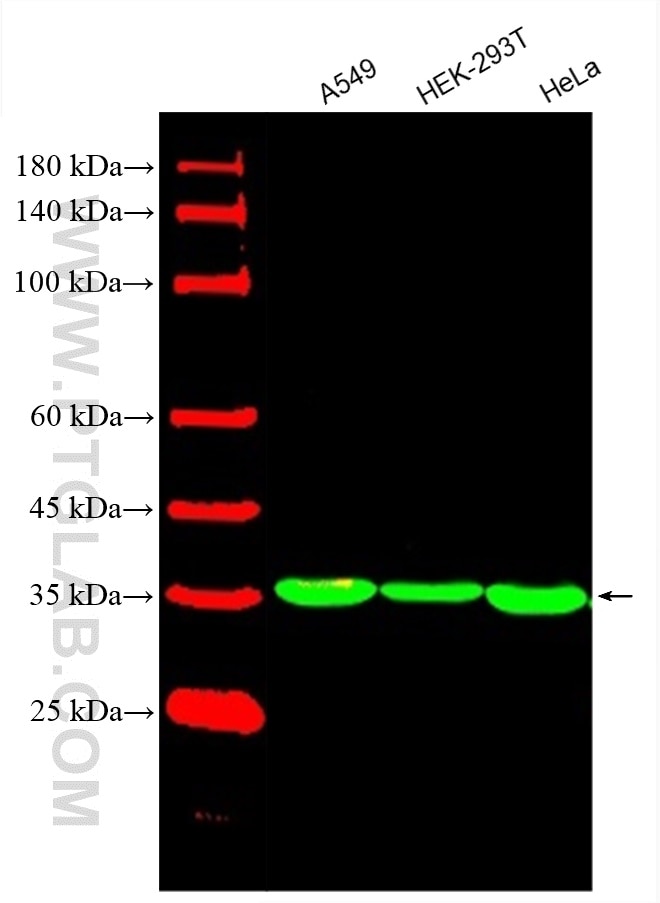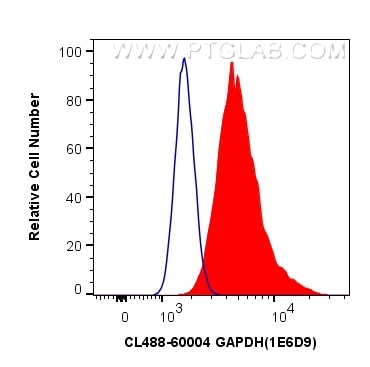- Phare
- Validé par KD/KO
Anticorps Monoclonal anti-GAPDH
GAPDH Monoclonal Antibody for WB, FC (Intra)
Hôte / Isotype
Mouse / IgG2b
Réactivité testée
Humain, levure, poisson-zèbre, rat, souris
Applications
WB, FC (Intra)
Conjugaison
CoraLite® Plus 488 Fluorescent Dye
CloneNo.
1E6D9
N° de cat : CL488-60004
Synonymes
Galerie de données de validation
Applications testées
| Résultats positifs en WB | cellules A549, cellules HEK-293, cellules HeLa, cellules Jurkat |
| Résultats positifs en FC (Intra) | cellules HeLa, |
Dilution recommandée
| Application | Dilution |
|---|---|
| Western Blot (WB) | WB : 1:2000-1:16000 |
| Flow Cytometry (FC) (INTRA) | FC (INTRA) : 0.40 ug per 10^6 cells in a 100 µl suspension |
| It is recommended that this reagent should be titrated in each testing system to obtain optimal results. | |
| Sample-dependent, check data in validation data gallery | |
Applications publiées
| WB | See 11 publications below |
Informations sur le produit
CL488-60004 cible GAPDH dans les applications de WB, FC (Intra) et montre une réactivité avec des échantillons Humain, levure, poisson-zèbre, rat, souris
| Réactivité | Humain, levure, poisson-zèbre, rat, souris |
| Réactivité citée | rat, Humain, souris |
| Hôte / Isotype | Mouse / IgG2b |
| Clonalité | Monoclonal |
| Type | Anticorps |
| Immunogène | GAPDH Protéine recombinante Ag0766 |
| Nom complet | glyceraldehyde-3-phosphate dehydrogenase |
| Masse moléculaire calculée | 36 kDa |
| Poids moléculaire observé | 36 kDa |
| Numéro d’acquisition GenBank | BC004109 |
| Symbole du gène | GAPDH |
| Identification du gène (NCBI) | 2597 |
| Conjugaison | CoraLite® Plus 488 Fluorescent Dye |
| Excitation/Emission maxima wavelengths | 493 nm / 522 nm |
| Forme | Liquide |
| Méthode de purification | Purification par protéine A |
| Tampon de stockage | PBS with 50% glycerol, 0.05% Proclin300, 0.5% BSA |
| Conditions de stockage | Stocker à -20 °C. Éviter toute exposition à la lumière. Stable pendant un an après l'expédition. L'aliquotage n'est pas nécessaire pour le stockage à -20oC Les 20ul contiennent 0,1% de BSA. |
Informations générales
Glyceraldehyde-3-phosphate dehydrogenase (GAPDH) catalyzes the phosphorylation of glyceraldehyde-3-phosphate during glycolysis. GAPDH participates in nuclear events including transcription, binding RNA, RNA transportation, DNA replication, DNA repair and apoptosis. Being stably and constitutively expressed at high levels in most tissues and cells, GAPDH is considered a housekeeping protein. It is widely used as a control for RT-PCR and also loading control in electrophoresis and Western blotting. GAPDH is normally expressed in cellular cytoplasm or membrane, but can occasionally translocate to the nucleus after the addition of post-translational modifications such as S-nitrosylation. This antibody is raised against full length GAPDH of human origin. It can recognize the 36 kDa GAPDH protein in most cells/tissues. In addition, a band below 36 kDa can always be detected as the isoform or spliced product of GAPDH (PMID: 23885286, 23877755, 19368702). Please note that some physiological factors, such as hypoxia and diabetes, increase GAPDH expression in certain cell types.
Protocole
| Product Specific Protocols | |
|---|---|
| WB protocol for CL Plus 488 GAPDH antibody CL488-60004 | Download protocol |
| Standard Protocols | |
|---|---|
| Click here to view our Standard Protocols |
Publications
| Species | Application | Title |
|---|---|---|
Aging (Albany NY) Coagulation factor 2 thrombin receptor promotes malignancy in glioma under SOX2 regulation. | ||
Cell Commun Signal Integral membrane protein 2A inhibits cell growth in human breast cancer via enhancing autophagy induction. | ||
Front Oncol SRSF3 Expression Serves as a Potential Biomarker for Prognostic and Immune Response in Pan-Cancer. | ||
Sci Rep Comparative analysis of pathophysiological parameters between emphysematous smokers and emphysematous patients with COPD. | ||
Exp Cell Res CLEC12B suppresses lung cancer progression by inducing SHP-1 expression and inactivating the PI3K/AKT signaling pathway. | ||
Virus Res Interaction of porcine reproductive and respiratory syndrome virus major envelope proteins GP5 and M with the cellular protein Snapin. |




